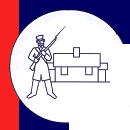 |
|
|

|
|
New Zealand Fencible Society Incorporated |
 WHO WERE THE FENCIBLES? The Royal New Zealand Fencibles were corps of retired soldiers from Britain and Ireland, often referred to as 'Pensioners', who enlisted as a military reserve to act as a 'defence force' for the protection of the early settlers in the fledgling town of Auckland, New Zealand. There were over 2,500 men, women and children who arrived in New Zealand during the years 1847 - 1852. They settled in the now south and eastern suburbs of Auckland; Onehunga, Otahuhu, Panmure and Howick. In return for availability in case of attack and attendance at parades the Fencibles were provided with a cottage and land which after seven years service they would own. FENCIBLE HISTORY HISTORY: In 1846 Governor Grey requested a military force from his superiors in Britain, as he was concerned about the 'unrest' between the Maori and the early settlers in New Zealand. The English Parliament however approved a detachment of retired soldiers to be known as 'The Royal New Zealand Fencible Corps' to be recruited and sent to New Zealand. (The word 'Fencible' comes from the word 'defence' which this detachment of retired soldiers were required to do as opposed to a unit of fighting men.) ENLISTMENT: Conditions for enlistment for the Royal NZ Fencible corps were posted in every camp in the British Isles where Military Regiments were stationed. Some of the conditions for enlistment were: The men had to be under the age of 48 years of age (later lowered to 41 years due to the numbers applying being so great), with a minimum of 15yrs military service. They needed to be over 5ft 5in in height, of good character, industrious habits, robust frame and be medically approved as fit for occasional military duties. Those approved would be enrolled to serve for 7 years on the following terms. They would receive free passage to New Zealand for themselves, their wives and families. On arriving in NZ each pensioner would be put in possession of a cottage of 2 rooms on an acre of land. Each man was required to attend military exercise for 12 days per annum and church parade each Sunday. On the termination of 7 years service the cottage and allotment would become the absolute property of the Pensioner. SHIPS: The Fencibles and their families arrived in Auckland, New Zealand between 1847 and 1852 on board the following ships. Ramillies - Arrived 5 August 1847; Captain McLean; 67 pensioners, 57 women, 123 children; Major William Henry Kenny, 73rd Regt including Lieutenant Colonel Bolton, Royal Engineers and 12 sappers and miners; surgeon Dr Cunningham RN. Minerva - Arrived 8 October 1847; Captain McBrath; 80 pensioners, 67 women, 145 children; Captain Charles Henry Montressor Smith, 55th regt including Major General Dean Pitt, Captain Greenwood; Surgeon Dr Mahon. Sir Robert Sale - Arrived 11 October 1847; Captain Loader; 74 pensioners, 69 women, 142 children; Captain Alexander McDonald; surgeon Dr John I Lancaster MD. Sir George Seymour - Arrived 26 November 1847; Captain Thomas W Millman; 78 pensioners, 63 women, 114 children; Major John Gray, 40th Reg (Commandant RNZ Fencibles); surgeon Dr Goldney. Clifton - Arrived 23 January 1848; Captain Kettlewell; 79 pensioners, 72 women, 161 children; Lieutenant Owen Wynne Gray; surgeon Dr Arthur Saunders Thompson. Ann - Arrived 16 May 1848; Captain C S Walker; 74 pensioners, 70 women, 153 children; Lieutenant John Annesley Hickson; surgeon Dr Bacot. Berhampore - Arrived 16 June 1849; Captain T B Smith; 80 pensioners, 67 women, 101 children; Captain John Jermyn Symonds; surgeon Dr Carr. Oriental Queen - Arrived 18 September 1849; Captain Thomas; 71 pensioners, 62 women, 108 children; Captain Theodore Minet Hautain, 39th Regt; surgeon Dr T Hunt. Inchinnan - Arrived 27 May 1852; Captain T Ennis; 78 pensioners, 68 women, 113 children; surgeon Dr Henry Rickards. Berwick Castle - Arrived 13 December 1852; Captain Andrew Latto/Latta; 40 pensioners, 37 women, 68 children; Seargent Timothy Carroll, 9th Regt Foot; surgeon Dr James Jackson 2nd Class. FENCIBLES The men numbered 721 and together with their families comprised a total of over 2,500 new settlers for the villages of Onehunga, Otahuhu, Howick and Panmure. The men had served in many regiments of the British Army in many parts of the world. They were used to harsh conditions and many were "pensioned out" as being unfit for further active service, largely due to rheumatism. Sometimes wives and children would have marched behind the regiment. A large number of the families were from Ireland, which was in the middle of the famine period, and all would have been leaving for a better life in New Zealand. The promise of owning land would have been a great incentive. When the first contingent arrived it had not been decided where they should settle. The cottages were not built. The families quickly settled into life in New Zealand, building their own houses, growing vegetables and finding work on the neighbouring farms. The Fencibles were a large group of immigrants who swelled Auckland's population at the time. They created the four villages, now suburbs of Auckland. They were instrumental, in the creation of roads, bridges and lines of communication. They shaped the infrastructure of churches, schools, shops and local governing bodies. Now it is estimated that there are over a quarter of a million descendants of Fencible families living today spread around the world. The villages are now bustling communities. The Fencibles came for a better life, they committed themselves to developing their communities with their labour and their limited resources. They are to be remembered with respect, for without their service the shape of Auckland would have been a very different place to what it is today. |
|
Copyright © 2003 New Zealand Fencible Society Incorporated. All Rights Reserved. |